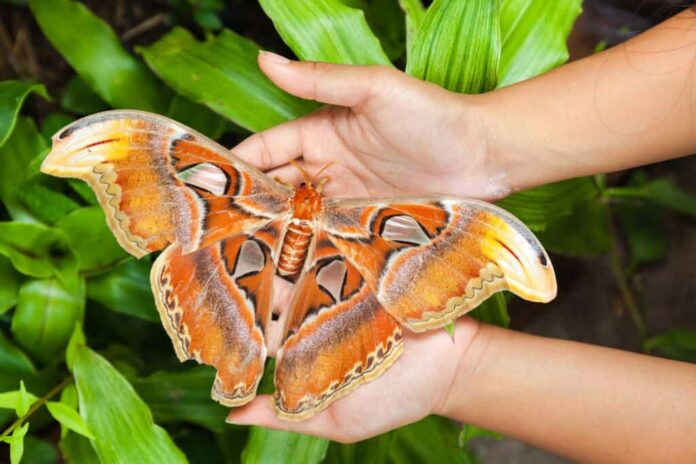What do moths eat – Moths are a fascinating group of insects that belong to the order Lepidoptera, along with butterflies. There are over 160,000 species of moths worldwide, with new species being discovered all the time. They come in a wide range of sizes, colors, and patterns, from the tiny pygmy moths to the giant Atlas moth, which has a wingspan of up to 30 cm.
Moths play important ecological roles in various ecosystems. They serve as important pollinators, food sources for other animals, and indicators of environmental health. Moths are also known for their unique behavior, such as their attraction to light sources, known as phototaxis.
Moths have many unique adaptations that enable them to thrive in different environments. For example, some species have evolved camouflage patterns on their wings to blend in with their surroundings, while others have developed bright and vibrant colors to ward off predators. Some species have also developed the ability to mimic other insects or even bird droppings to avoid being eaten.
While moths can be considered pests in some situations, they also have many benefits. Silk, one of the world’s most valuable and highly prized fabrics, is produced by the silk moth caterpillar. Additionally, moths have been used in scientific research for centuries, with their unique biology and behavior providing insight into genetics, evolution, and ecology.
In this article, we will discuss everything from what do moths eat to their life cycle, body features, habitat, etc.
Moth’s Growth and Life Cycle
Moths undergo a process of metamorphosis, transforming from a caterpillar to adult moths. The life cycle of a moth typically involves four stages: egg, larva, pupa, and adult.
The female moth lays her eggs on a suitable food source for the hatching larvae. Once hatched, the larvae, or caterpillars, feed voraciously on their food source, growing rapidly in size. During this time, they shed their skin several times, a process called molting, to accommodate their growing bodies.
After reaching its maximum size, the caterpillar enters the pupal stage, where it undergoes a remarkable transformation. Inside the pupa, the caterpillar’s body is broken down and reorganized into the adult form of the moth. This process can take anywhere from a few weeks to several months, depending on the species and environmental conditions.
Finally, the adult moth emerges from the pupa, with fully developed wings and reproductive organs. The moth’s wings, which were tightly folded and protected within the pupal casing, gradually expand and harden, allowing the moth to fly.
Moth’s Body Features
Moths have a range of body features that enable them to survive in their environment. One of the most distinctive features of moths is their wings, which are covered in scales. These scales give the wings their color and pattern and help to protect the wings from damage. Moth wings come in a variety of shapes and sizes, from the large, broad wings of the Atlas moth to the narrow, pointed wings of the hawk moth.
Moths also have a proboscis, a long, tube-like mouthpart that they use to feed on nectar and other fluids. The proboscis can be coiled up when not in use, making it a convenient adaptation for flying insects. Moths also have large, compound eyes that enable them to see in low light conditions, which is important for their nocturnal lifestyle.
Another important feature of moths is their ability to produce pheromones, which they use to communicate with each other. Male moths, for example, can detect the pheromones released by female moths from miles away, allowing them to find potential mates.
Moth’s Habitat
Moths are incredibly adaptable creatures, capable of thriving in a wide variety of habitats. From dense forests to barren deserts, moths can be found in almost every corner of the planet. In fact, if there’s one thing moths are known for, it’s their ability to make themselves at home in just about any environment – even your closet! So whether you’re hiking through the woods or simply doing laundry, keep an eye out for these crafty insects. You never know where you might find them!
Just be sure to check your sweaters for any unwanted guests before putting them on – you wouldn’t want to accidentally wear a moth to work!
What do Moths eat?
Moths are known for their incredible adaptability, and their diet is no exception. These crafty insects are capable of eating a wide variety of foods, from bugs and clothing to seeds and flowers and nectar. Some species of moth even go so far as to eat nothing at all, relying instead on stored nutrients to survive.
- Bugs: Let’s start with the bugs. Many species of moth feed on insects, including other moths. These insectivorous moths have sharp mandibles that they use to capture and consume their prey. Some of the insects they feed on include caterpillars, beetles, and flies.
- Clothing: Next up is clothing. Yes, you read that right – some moths feed on clothing! The larvae of the clothes moth, for example, are notorious for their ability to chew through wool, silk, and other natural fibers. These little rascals can cause serious damage to clothing and textiles if left unchecked.
- Seeds and Cereals: Moving on to seeds and cereals, some moths are known to feed on grains and other plant-based foods, including rice and corn. The Indian meal moth, for example, is a common pest in kitchens and pantries, where it feeds on a variety of grains and cereals.
- Flower Nectar: Now, let’s talk about flowers nectar. Many species of moth are pollinators, and they play an important role in the reproduction of many plant species. These moths feed on the nectar produced by flowers, using their long proboscis to reach deep into the flower to extract the sweet liquid.
- Nothing: And finally, we have the moths that don’t eat anything at all. These moths, known as non-feeding moths, have no functional mouthparts and rely on stored nutrients to survive. While it may seem strange to imagine an insect that doesn’t eat, these moths are actually quite common and can be found in a variety of habitats around the world.
Wrapping Up
In conclusion, there is no single answer to what do moths eat, as moths are fascinating insects with an incredibly diverse range of diets. They are capable of eating everything from bugs and clothing to seeds and flowers’ and nectar. Some species of moth even survive without eating anything at all, relying solely on stored nutrients. Their adaptability and resilience allow them to thrive in a wide range of habitats, from dense forests to urban areas. While some species of moth can be pests, causing damage to clothing and food, others play a crucial role in pollination and maintaining healthy ecosystems.
Whether you love them or hate them, moths are a truly remarkable part of the natural world, and their ability to eat such a wide range of foods is just one of the many fascinating things about them. And if you ever come across a non-feeding moth, just remember that it’s not hungry – it’s just living life on its own terms!
Frequently Asked Questions (FAQs):
- What are moths attracted to?
Moths are attracted to light and warmth, which can lead them to fly toward lamps, candles, and other sources of illumination. Some species of moth are also attracted to floral scents and may be drawn to gardens or other areas with a high concentration of flowers. - Can moths bite you?
Moths do not bite people, as they do not have the necessary mouthparts to do so. However, some species of moth may cause irritation or allergic reactions in people who come into contact with their scales or hairs. - What kills moths instantly?
Moths can be killed instantly with a variety of methods, including using insecticides, trapping them with sticky traps or light traps, or freezing them. Vacuuming can also be an effective way to get rid of moths and their larvae. - How long do moths live?
The lifespan of a moth varies depending on the species and the environment in which it lives. Some moths may live for only a few days, while others can live for several months or even up to a year. - Can moths cause damage to clothing and other materials?
Yes, some species of moth, such as the clothes moth, can cause significant damage to clothing, textiles, and other materials. The larvae of these moths feed on natural fibers, such as wool and silk, and can cause holes and other damage if left unchecked. Regular cleaning and storing clothing and textiles properly can help prevent moth damage.

















